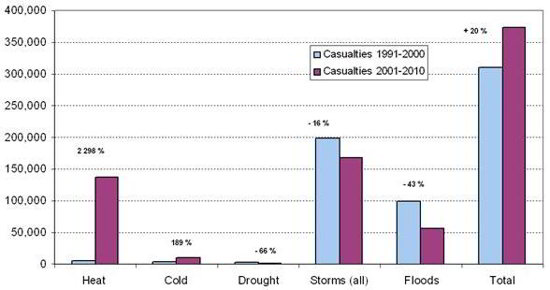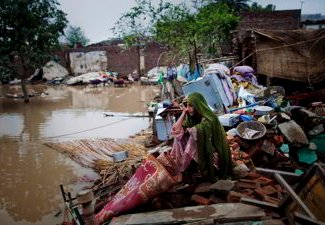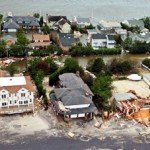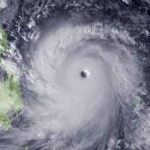Results from WMO’s survey showed that nearly 94% of reporting countries had their warmest decade in 2001-2010 and no country reported a nation-wide average decadal temperature anomaly cooler than the long term average.
Some 44% of countries in the survey reported nation-wide hottest temperature records in 2001-2010, compared to 24% in 1991-2000. Coldest daily minimum temperature absolute records showed an opposite pattern: In 1961-1970, nearly 32 % of the countries reported nation-wide lowest minimum temperature values. The percentage decreased to 11% in 2001-2010.
The 2001-2010 decade was the second wettest since 1901. Globally, 2010 was the wettest year since the start of instrumental records.
Most parts of the globe had above-normal precipitation during the decade. The eastern USA, northern and eastern Canada, and many parts of Europe and central Asia were particularly wet.
According to the WMO survey, floods were the most frequently experienced extreme weather events over the course of the decade. Eastern Europe was particularly affected in 2001 and 2005, India in 2005, Africa in 2008, Asia (notably Pakistan, where 2,000 people died and 20 million were affected) in 2010, and Australia, also in 2010.
Droughts affected more people than any other kind of natural hazards owing to their large-scale and long-lasting nature. The decade 2001–2010 saw droughts occur in all parts of the world. Some of the highest-impact and long-term droughts struck Australia (in 2002 and other years), East Africa (2004 and 2005, resulting in wide-spread loss of life) and the Amazon Basin (2010) with negative environmental impacts.
Tropical Cyclones:
Between 2001 and 2010, there were 511 tropical cyclone related events which resulted in a total of nearly 170,000 persons reported killed, over 250 million people reported affected and estimated economic damages of US $ 380 billion.
According to the U.S. National Oceanic and Atmospheric Administration (NOAA), 2001-2010 was the most active decade since 1855 in terms of tropical cyclone activity in the North Atlantic Basin. An average of 15 named storms per year was recorded, well above the long-term average of 12.
The North Indian Ocean saw the deadliest tropical cyclone recorded during the decade, when Tropical Cyclone Nargis struck Myanmar in early May 2008. More than 138,000 people were reported killed or missing, eight million people were affected and thousands of homes were destroyed.
Impacts:
During the decade 2001-2010, more than 370,000 people died as a result of extreme weather and climate conditions, including heat waves, cold spells, drought, storms and floods, according to the data provided by the Centre for Research on the Epidemiology of Disasters (CRED). This was 20% higher than 1991-2000. This increase is due mainly to the 2003 heat wave in Europe and the 2010 in Russia which contributed to an increase of more than 2000% in the global death toll from heat waves (from less than 6,000 in 1991-2000 to 136,000 in 2001-2010).
On the other hand, there was a 16% decline in deaths due to storms and 43% decline in deaths from floods, thanks mainly to better early warning systems and increased preparedness and despite an increase in populations in disaster-prone areas.
According to the 2011 Global Assessment Report, the average population exposed to flooding every year increased by 114% globally between 1970 and 2010, a period in which the world’s population increased by 87% from 3.7 billion to 6.9 billion. The number of people exposed to severe storms almost tripled in cyclone-prone areas, increasing by 192%, in the same period.

Much research is being conducted into whether it is possible to attribute individual extreme weather events to climate change rather than natural variability. Scientists increasingly conclude that the likelihood of an event such as the 2003 European heat wave was probably substantially increased by rising global temperatures. It is, therefore, important to develop this research to strengthen climate science and to use it to improve climate services to help society adapt to climate change.
Check the following link to read/download the Full Report:
http://library.wmo.int/opac/index.php?lvl=notice_display&id=15110
Source: WMO.
The World Meteorological Organization (WMO) is the United Nations System’s authoritative voice on Weather, Climate and Water.
Climate data and information used in this report was provided by a number of international, regional and national institutions. Most of the data on impacts caused by extreme events was provided by the Centre for Research on the Epidemiology of Disasters (CRED). Details on data sources, contributors and references are included in the full report.















